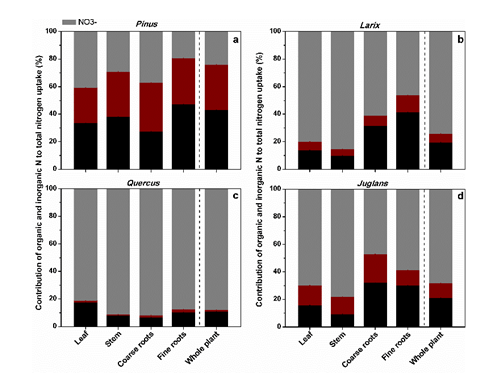Nitrogen (N) is a major plant nutrient that influences the productivity, composition and function of forests. Plants compete with soil microbes for soil N in the forms of inorganic and organic N. Relatively low soil nutrient concentrations, especially available nitrogen, in natural secondary forests and larch plantations in northeast China may constrain tree growth there.
However, fundamental questions of how plant species within these forests partition and compete for limited soil N resource remain unclear.
Researchers from Institute of Applied Ecology (IAE), Chinese Academy of Sciences selected two coniferous species, Pinus koraiensis and Larix keampferi and two broadleaf species, Quercus mongolica and Juglans mandshurica, that are common in northeast China to study their uptake of different N forms. 15N tracer experiment with ammonium, nitrate and glycine was used to determine if these tree species show preference or flexibility in N use. Except Pinus koraiensis, the other three species, Larix keampferi, Quercus mongolica, and Juglans mandshurica preferentially used and transferred nitrate to leaves, with nitrate uptake constituting 68~88% of total N use. Glycine contributed 43% to total N uptake of Pinus koraiensis, but only 11~21% to N uptake by the other three species. Retention of glycine carbon versus nitrogen in Pinus koraiensis roots indicated that 36% of glycine uptake was retained intact.
It was suggested that these dominant tree species in natural secondary forests in northeast China partitioned limited N resource by varying uptake of glycine, ammonium and nitrate, with all species, except Pinus koraiensis, using nitrate that are most abundant within these soils. Such N use pattern was in consistence with the observed higher retention of deposited nitrate than ammonium into aboveground biomass in these secondary forests. Increasing N deposition may thus influence the coexistence of plant species and lead to community composition change in these forest stands, given that some coniferous trees may compete less well than other species toward increased nitrate availability.
It was published with the title of “Uptake patterns of glycine, ammonium, and nitrate differ among four common tree species of northeast China” on Frontiers in Plant Science.
This work was financially supported by the National Key Research and Development Program of China, the Strategic Priority Research Program of Chinese Academy of Sciences, the National Natural Science Foundation of China, the Key Research Program of Frontier Sciences of Chinese Academy of Sciences, and the K. C. Wong Education Foundation.

Fig 1. N uptake pattern by four common tree species in natural secondary forests in northeast China (Image by ZHU Feifei).
Email: yueqian@iae.ac.cn
Publication Name: ZHU Feifei et al.




